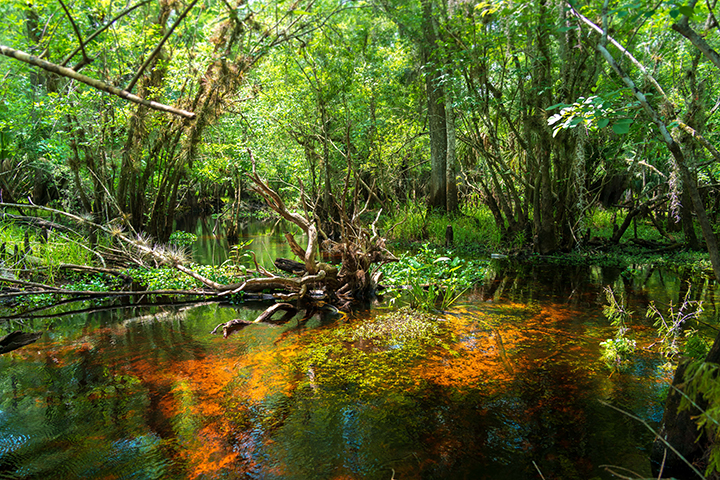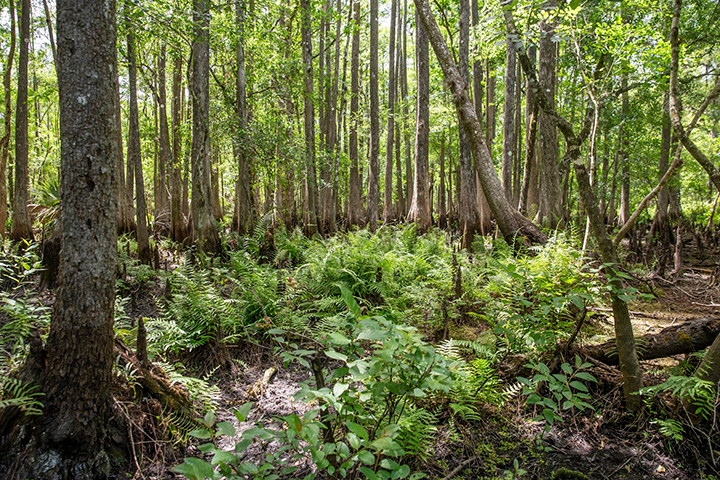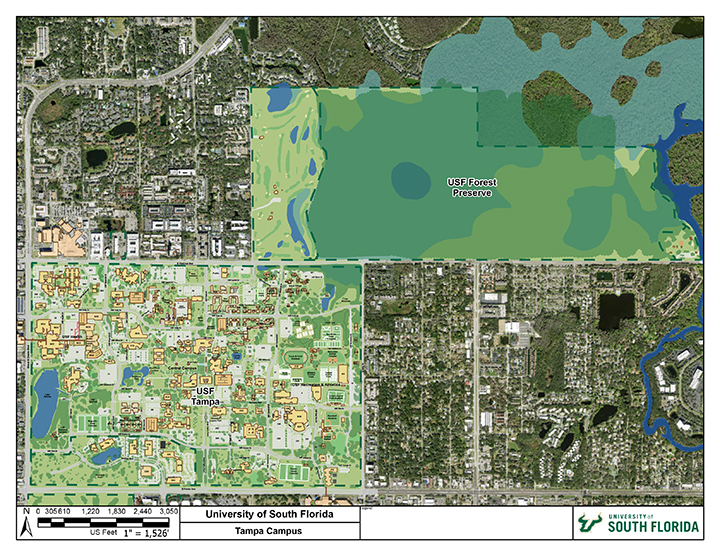Where We Are
Forest Preserve

Photo Credit: Luke Myers
Nestled within the heart of Tampa lies the captivating USF Forest Preserve, a haven of natural wonders waiting to be explored. With its diverse tapestry of ecosystems, from serene sandhills to enchanting cypress domes, the Preserve encapsulates the unique beauty of the Tampa Bay region.
Embracing its role as a cornerstone of the University, the Preserve stands as a vital treasure trove of knowledge. It plays a pivotal role in advancing student and faculty research, offering an expansive canvas for discovery. Much scholarly work is conducted in this living laboratory, resulting in over 70 research papers published in esteemed peer-reviewed journals, as well as the completion of more than 20 Masters of Science theses and PhD dissertations. The Forest Preserve's outdoor classroom has drawn researchers as well as undergraduate and graduate classes from various disciplines, including Anthropology, Civil Engineering, GeoSciences, and Integrative Biology.
Request use of the Preserve for research and classes.
To learn more about the history of the USF Forest Preserve, view this StoryMap prepared by the USF Libraries Special Collections - Florida Environment and Natural Histories.
Sandhill Habitat and Fire Dependent Environments
Sandhill habitat is unique to Florida, specifically in the north and central areas of the state. Sandhills are not unique to Florida but extend throughout the Southeast Coastal Plain – east Texas to the Carolinas. It’s true that this community does not occur south of the southern terminus of the lake Wales Ridge in south-central Florida. What makes Florida (and the rest of the US) special in terms of sandhill habitat is that it has been reduced to a fragment of its former occurrence. This makes preserving and managing what’s left significant.
Excerpted from FNAI for a good perspective on sandhill:
"This longleaf pine ecosystem has experienced a 98 percent decline in acreage throughout its range and is considered critically endangered (Noss et al. 1995; Stein et al. 2000). From 1936 to 1995, Florida experienced a 90 percent decline in longleaf pinelands due to conversion to pine plantations, development, and agriculture (Kautz 1998)."
A defining characteristic of the sandhill community is its dependence on regular and frequent fire. Although wildfire is mostly viewed as destructive force that is detrimental to natural environments, some communities such as sandhill are dependent on fire. Ground litter from the accumulation of pine needles and decaying vegetation remain on the ground, covering the open sand and low-growing vegetation. This accumulation blocks the sunlight from penetrating the ground and thus stifles reproduction and new growth. Fire benefits these areas by clearing the accumulation allowing new growth to sprout and by recycling important nutrients. This is essential in maintaining biodiversity and stimulating the production of wildlife food. Despite this essentialness of fire to this system, human intervention has largely suppressed the introduction of fire This has led to the accumulation of an unhealthy number of flammable fuels and these conditions create damaging fires that can kill even fire-dependent species and fires that are difficult to control.
As a part of the ECORE System, regular prescribed burns are conducted at the USF Forest Preserve to maintain ecological balance.
Vegetation and Wildlife

The USF Forest Preserve hosts a great diversity of plants and animals. The communities on the property are dominated by species indicative of each. The sandhills are dominated by mature longleaf pine (Pinus palustris) with scattered turkey and bluejack oaks (Quercus laevis and Q. incana, respectively), with an understory of wiregrass (Aristida stricta) and a great diversity of indicative wildflowers. More-mesic uplands are characterized by live oaks (Quercus virginiana) and/or slash pine (Pinus elliottii). Saw palmetto (Serenoa repens) is the dominant understory species in these areas. Laurel oak (Quercus laurifolia)-dominated areas are mostly hydric and characterized by an understory dominated by graminoids. Most wetlands within the Forest Preserve, however, are characterized as cypress swamp, dominated by bald cypress (Taxodium distichum). A diversity of epiphytes are found in the wetland portions of the property. One of the wildlife species the USF Forest Preserve is the gopher tortoise (Gopherus polyphemus). Gopher tortoises are native to the Southeast Coastal Plain and are most common in well-managed sandhills and in this community they are regarded as a keystone species. Habitat loss from mismanagement of their habitat is their main threat to them and the reintroduction of ecologically driven fire is the most effective tool in maintaining a healthy population of these state-threatened species. A major contribution of gopher tortoises to the overall ecology of sandhills is their burrowing. These serve as shelter from weather and fires. During fires and during periods of high temperatures, other animals take shelter in their burrows. Through the introduction of regular prescribed burns, USF aims to maintain and enhance the gopher tortoise population within the Preserve.
Resources
-
